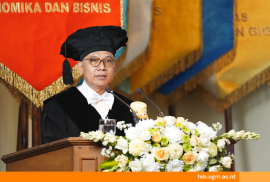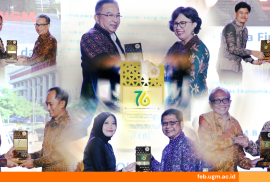
Photography is one of the most essential elements in supporting public communication. The presence of photos is not just a compliment but strengthens the visual narrative, clarifies the message, and forms a stronger image of the institution.
To improve the photography skills of professional staff engaged in public relations, FEB UGM organized a photography workshop. Presenting Ferganata Indra Riatmoko, who is a photographer from Kompas Daily
Indra, on that occasion, provided in-depth insight into how photography techniques can support visual communication and strengthen institutional branding. Understanding the types of cameras, ranging from DSLR, mirrorless, and smartphones to drones, is essential for producing quality images according to documentation needs.
At the beginning of his presentation, Indra talked about the concept of the exposure triangle, which includes aperture, shutter speed, and ISO. The idea is key in managing lighting so that photos are clear and aesthetically appealing. Meanwhile, lighting techniques, including natural and artificial light and the three-point lighting principle, help create the right atmosphere and visual focus in each shot.
Indra explains that photo composition is a significant factor in effectively conveying a message. The rule of thirds, framing, and negative space can draw attention and strengthen the visual narrative. These approaches help photographers produce images that are not just beautiful but also communicative and meaningful.
A good documentation technique utilizes the EDFAT method (Entire, Detail, Frame, Angle, Time) to capture various points of view and essential details in an event. Indra explains that this allows photos to be more informative and story-rich. Even the use of smartphones, with special tips, can produce equally effective documentation.
Ethics in public relations photography also receive special attention. According to Indra, honesty in photo presentation, respect for the subject’s privacy, and sensitivity to the social context are the cornerstones so that photo works do not cause controversy or misinterpretation. Basic editing, such as color correction and exposure, must be done wisely, maintaining the photo’s authenticity while enhancing the visual quality.
In addition to visual techniques, Indra mentions that preparing complete captions with 5W+1H elements (What, Who, When, Where, Why, How) supports the narrative and verification of information conveyed through photos. Neat file management, including systematic naming and storage in the Cloud, is the best practice to maintain security and ease of access to documentation.
At the end of his presentation, Indra reminded us that it is essential to avoid common mistakes such as blurry photos, poor lighting, sloppy composition, and overly crowded backgrounds to ensure that the final result is always professional and effective in conveying the message. All this shows that public relations photography is an art and an integrated communication strategy, not just about taking pictures.
Report by: Orie Priscylla Mapeda Lumalan
Editor: Kurnia Ekaptiningrum
Sustainable Development Goals









